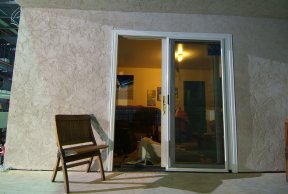News Detective: Watching a House Rock
Share this:
- Share via email (Opens in new window) Email
- Click to share on Facebook (Opens in new window) Facebook
- Click to share on X (Opens in new window) X
- Click to share on Pinterest (Opens in new window) Pinterest
- Click to share on Reddit (Opens in new window) Reddit
- Share to Google Classroom (Opens in new window) Google Classroom
- Click to print (Opens in new window) Print

Sid Perkins watches a house rock.
On the afternoon before the big earthquake simulation, I took a tour of the test house with Andre Filiatrault, one of the engineers in charge. He showed me how some of the furniture was attached to the walls or floor, just as many engineers in California recommend for real homes in their earthquake-prone state.
We also went beneath the house, where we saw the huge pistons—each the size of an adult’s thigh—that would push and pull the shake tables back and forth during the simulation.
On the tour, Filiatrault expressed concern about the damage that the townhouse might suffer. “I don’t think the house will fare too well,” he predicted.
On the morning of the test, the simulated quake—just like the real one that had happened in California nearly 12 years before—began with a few small tremors. The entire building rumbled. Then, the earthquake struck hard. Anything that wasn’t fastened down was on the move.
Flower boxes plunged from their perches beneath second-story windows. In the dining room, the video cameras revealed that the chandelier danced, the water glasses fell over, and the place settings slid back and forth on the table as if an invisible magician were practicing a tablecloth trick.
In the dorm-style bedroom, the cinder block–and-board bookcase toppled. So did the dresser, its contents, and the lamp and computer monitor on the desk. The intense shaking hurled a TV set more than 3 meters across the room. That and the other heavy items could have badly injured anyone in the room during a real quake, says John van de Lindt of Colorado State University.
While inspecting the damage after the test, a local radio reporter said, “This looks just like my teenager’s room.”
But in another bedroom, the story was different. A tall bookcase, which had been attached to the wall with brackets, didn’t fall, although its contents of stuffed animals, children’s books, and other bric-a-brac tumbled out. A small TV set, chained to a table that had been bolted to the floor, likewise stayed in place. Results in this room show that homeowners can do a lot to prevent some damage and injuries, says Filiatrault.
In the garage, a station wagon hopped around like a lowrider. One water heater, strapped to the wall as current California law requires for new homes, held its ground. Another heater—unconstrained, as heaters in many older homes are—fell over in the first 2 seconds of the quake.
While most of the structure’s contents got tossed around, the home didn’t collapse. In fact, it withstood the quake better than expected, says Filiatrault. “I’m surprised the windows didn’t break,” he notes.
After the test, the structure leaned in one direction at an angle of about 1 degree. That might not sound like much, but Filiatrault worries about the building’s integrity. “If I lived in this home in California, I think I’d camp out in the backyard until an engineer could look at it,” he says.—Sid Perkins